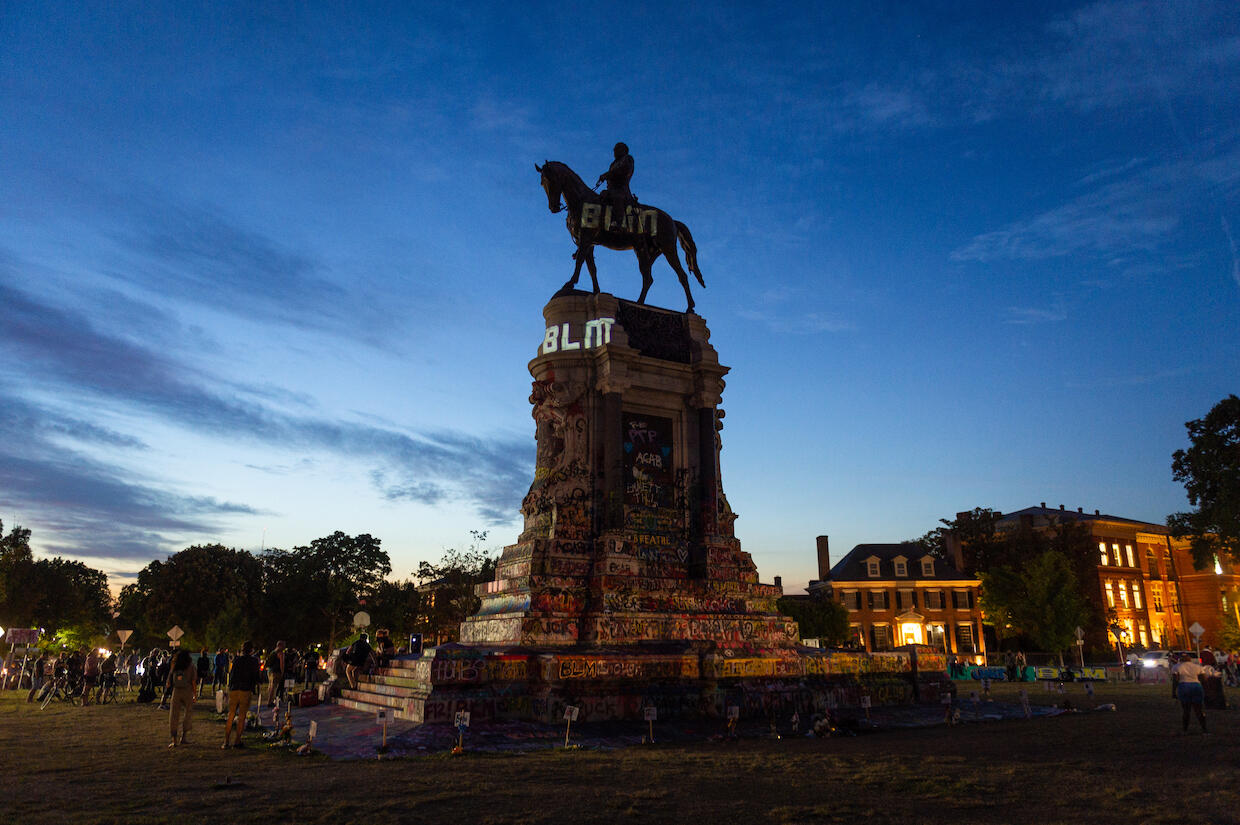
Dec. 14, 2020
Alum’s art projections transform the Lee monument — and land the cover of National Geographic
Share this story
On the cover of National Geographic’s “The Year in Pictures” issue is an image of the Robert E. Lee monument covered in racial-justice graffiti and a projection displaying the face of George Floyd on the pedestal and “BLM” on the statue.
Since the spring, artists Dustin Klein and Alex Criqui — who graduated from the Department of History in the Virginia Commonwealth University College of Humanities and Sciences — have projected onto the monument images of Black people killed by police, including Floyd, Breonna Taylor and Marcus-David Peters, historical figures who fought for equality, such as Harriet Tubman, the Rev. Martin Luther King Jr., Frederick Douglass and more.
Criqui recently discussed his and Klein’s Reclaiming the Monument project with VCU News, saying he is proud to have contributed to the transformation of the Confederate monument into a “symbol of liberation.”
What inspired you and Klein to undertake this project to re-contextualize the monument with projections?
When we first went out to project on the monument, it was mostly driven by a desire to do something that would support the community that was holding that space, visually. It seemed like a unique way that we could contribute that would be appropriate for two white men in a Black-led movement, and a way that we could help our city further reclaim that space.
Is there an overarching message you’ve sought to convey with the projections? What do you hope viewers walk away with?
I think the core of our message is that we want to live in an inclusive society, free of symbols designed to intimidate and propagate false racist historical narratives, and one that values Black lives and Black history.
We want to use our work as a way of bringing people together and creating positivity, which has thankfully been the response we have gotten from the vast majority of people we have met out there.
In our 133 years, National Geographic has never singled out one year for a retrospective like this. But if ever a year demanded that, 2020 does. https://t.co/N9BRTJXEDb
— National Geographic Magazine (@NatGeoMag) December 8, 2020
How often are you and Klein doing the projections currently?
We still go out when it seems like there is something we can say, and something we can contribute to the conversation, or there are messages coming from the community that we can help amplify. We want to continue our work out there until that statue comes down, at the very least, and are looking for more permanent solutions to continuing this project.
The projection of George Floyd and "BLM" depicted on the magazine's cover is one of the most iconic displays from this year at the circle. Do any of the other projections stand out for you? Or any others that particularly resonated?
The projections we have put up that have dealt with history have felt particularly powerful to me, as in many ways they succeed in using the monument's revisionist version of history against itself to the greatest extent. We have put up several images of Black Union soldiers of the United States Colored Troops, which have felt particularly powerful to see in that space, as they directly challenge the narratives that people like Robert E Lee fought for and those after him wished to put out into the world via the Lost Cause mythos.
We have also put up historical icons like Harriett Tubman, Frederick Douglass, Maggie Walker, and have featured speeches from James Baldwin, Martin Luther King Jr., Angela Davis and many others, which also felt very resonate in how they connected the struggle of our own times to the continual struggle that has been a part of our country since it's very beginning.
The Lee monument has been transformed and reclaimed by Black Lives Matter artists and activists, and has become a new and important symbol for the former capital of the Confederacy. As a part of the movement that made that happen, how do you reflect on these changes?
It has been a really amazing experience to see how our community has taken something that was once a symbol of hate and subjugation and turned it into a symbol of liberation. There have been many people who have put in work in that space, and many people who led the charge in reclaiming that space long before we became involved, so all credit goes to the activists and organizers who have been in this fight for years and who made everything we did possible.
It has been beautiful to see how our community's actions and the art which has grown around the monument have resonated with people all over the world, and I think it speaks to how ready the world is for a way forward into a new future that can accommodate and include all of us.
Subscribe to VCU News
Subscribe to VCU News at newsletter.vcu.edu and receive a selection of stories, videos, photos, news clips and event listings in your inbox.













